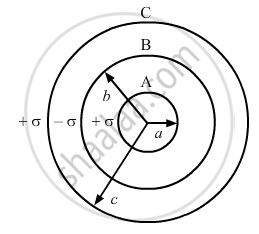Advertisements
Advertisements
Question
Three concentric metallic shells A, B and C or radii a, b and c (a < b < c) have surface charge densities + σ, −σ and + σ, respectively as shown in the figure

If shells A and C are at the same potential, then obtain the relation between the radii a, b and c.
Solution
If qA, qB and qC are the charges of the respective shells, then we have:
\[q_A = 4\pi a^2 \sigma\]
\[ q_B = - 4\pi b^2 \sigma\]
\[ q_C = 4\pi c^2 \sigma\]
Let VA and VC be the potentials of shells A and C.
A point on the surface of shell A lies inside the shells B and C.
\[\therefore V_A = \frac{1}{4 \pi\epsilon_0} . \frac{q_A}{a} + \frac{1}{4 \pi\epsilon_0} . \frac{q_B}{b} + \frac{1}{4 \pi\epsilon_0} . \frac{q_C}{c}\]
\[ = \frac{1}{4 \pi\epsilon_0}\left( \frac{4\pi a^2 \sigma}{a} - \frac{4\pi b^2 \sigma}{b} + \frac{4\pi c^2 \sigma}{c} \right)\]
\[ \Rightarrow V_A = \frac{\sigma}{\epsilon_0}\left( a - b + c \right)\]
A point on shell C lies outside both A and B.
\[\therefore V_C = \frac{1}{4 \pi\epsilon_0}\left( \frac{q_A}{c} + \frac{q_B}{c} + \frac{q_C}{c} \right)\]
\[ = \frac{1}{4 \pi\epsilon_0}\left( \frac{4\pi a^2 \sigma}{c} - \frac{4\pi b^2 \sigma}{c} + \frac{4\pi c^2 \sigma}{c} \right)\]
\[ \Rightarrow V_C = \frac{\sigma}{\epsilon_0}\left( \frac{a^2 - b^2}{c} + c \right)\]
If the shells A and C are at the same potential, then VA = VC.
\[i . e . , \frac{\sigma}{\epsilon_0}\left( a - b + c \right) = \frac{\sigma}{\epsilon_0}\left( \frac{a^2 - b^2}{c} + c \right)\]
\[ \Rightarrow \left( a - b + c \right) = \frac{a^2 - b^2}{c} + c\]
\[ \Rightarrow c\left( a - b \right) = a^2 - b^2 \]
\[ \Rightarrow c = a + b\]
APPEARS IN
RELATED QUESTIONS
A charge Q is distributed uniformly over a metallic sphere of radius R. Obtain the expressions for the electric field (E) and electric potential (V) at a point 0 < x < R.
Show on a plot the variation of E and V with x for 0 < x < 2R.
In an electric circuit containing a battery, the charge (assumed positive) inside the battery ____________ .
Sunita and her friends visited the exhibition. The policeman asked them to pass through a metal detector. Sunita's friends were initially scared of it. Sunita, however, explained to them the purpose and working of the metal detector.
Answer the following questions :
(a) On what principle does a metal detector work?
(b) Why does the detector emit a sound when a person carrying any metallic object walks through it?
(c) State any two qualities which Sunita displayed while explaining the purpose of walking through the detector.
A constant voltage is applied between the two ends of a uniform metallic wire. Some heat is developed in it. The heat developed is doubled if ______.
If the resistivity of an alloy is P and that of constitute metal is P1 then
A steady current of 1 A is flowing through the conductor. The number of electrons flowing through the cross-section of the conductor in 1 second is ______
For wiring in the home, one uses Cu wires or Al wires. What considerations are involved in this?
An electric current (I) flowing through a metallic wire is gradually increased. The graph of heating power (P) developed in it versus the current (I) is ______.
Current I flowing through a metallic wire is gradually increased. Show graphically how heating power (P) developed in it varies with the current (I).
